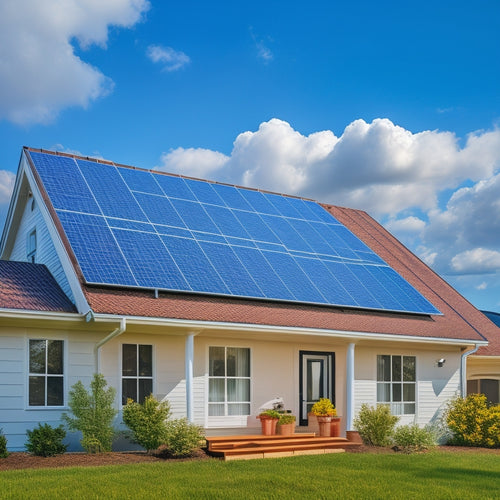
Optimizing Home Solar Power System Efficiency
Share
You can optimize your home solar power system's efficiency by taking a thorough approach. Start by evaluating your energy needs and conducting an extensive home energy audit to identify areas of inefficiency. Then, implement strategies to reduce energy consumption and optimize solar panel orientation, selecting the right inverter and energy storage system for your setup. Also, consider roof size and shade analysis to maximize energy production. By following these steps, you'll be well on your way to revealing your system's full potential and reaping the benefits of clean, renewable energy. Now, uncover the finer details that can take your system to the next level.
Overview
- Accurately evaluating energy consumption trends is crucial for sizing solar systems correctly and identifying opportunities for demand reduction strategies.
- Conducting a thorough home energy audit helps identify areas of energy inefficiency and optimizes solar system effectiveness and financial incentives.
- Proper solar panel orientation, placement, and seasonal adjustments are essential for maximizing energy production and system efficiency.
- Selecting the right inverter, compatible with the solar panel array and energy needs, ensures optimal energy conversion and system performance.
- Regular monitoring and maintenance are critical for detecting energy loss, addressing issues promptly, and ensuring the solar power system operates at peak efficiency.
Assessing Your Energy Needs
Regularly, homeowners overlook an essential step in optimizing their solar power system: evaluating their energy needs.
You must understand your energy consumption trends to determine the right system size and configuration for your home. Start by tracking your energy usage over time, identifying patterns and spikes in consumption.
Assess the efficiency of your household appliances, replacing old or inefficient ones with energy-star rated alternatives. This will help you reduce your overall energy demand, allowing your solar power system to provide a higher percentage of your energy needs.
Consider exploring cost-effective solutions to reduce upfront costs and installation expenses, as well as energy efficiency measures to lower overall consumption.
Home Energy Audit Tips
Now that you've assessed your energy needs, it's time to conduct a thorough home energy audit. This vital step helps identify areas of energy inefficiency, providing opportunities for cost savings and reducing your environmental impact.
Use smart technology to monitor your energy usage and pinpoint areas for improvement. Look for air leaks, insulation gaps, and inefficient appliances, as these can greatly affect your utility bills.
To optimize energy usage, review past utility bills for historical energy consumption data and analyze energy-intensive appliances for opportunities to improve efficiency. By addressing these issues, you'll not only reduce your energy consumption but also increase the effectiveness of your solar power system.
This, in turn, will lead to financial incentives, system longevity, and a smoother installation process. By optimizing your home's energy efficiency, you'll be well on your way to utilizing the full potential of renewable resources and sustainable solutions.
Solar Panel Orientation Matters
You're about to install solar panels, but have you considered the orientation of your solar array? The solar angle and panel alignment greatly influence your system's efficiency.
In the northern hemisphere, a south-facing orientation with a tilt between 30° to 40° is ideal for maximizing sun exposure. However, seasonal adjustments can be made to enhance energy production during different times of the year.
Ideal site selection, considering factors such as shading and wind direction, is also vital for improving energy production. Directional benefits can be achieved through precise installation techniques, factoring in geographical impact.
Consider investing in tracking systems, which can elevate performance optimization and result in significant efficiency gains.
Roof Size and Shade Analysis
You'll need to evaluate your roof's available space to determine how many solar panels can fit, considering factors like skylights, vents, and chimneys.
Next, you'll identify shading patterns caused by trees, buildings, or other obstructions that could impact energy production.
A thorough obstruction analysis will help you pinpoint potential issues and optimize panel placement for maximum energy output.
Roof Space Evaluation
Every rooftop has a unique set of characteristics that affect the performance of a solar power system. As you evaluate your roof space, consider the size and layout of your roof, as well as the material it's made of. The roof material impact can greatly affect the efficiency of your solar panels. For instance, a metal roof may be more energy-efficient than an asphalt shingle roof.
| Roof Characteristic | Impact on Solar Power System |
|---|---|
| Roof size | Larger roofs provide more space for solar panels, increasing energy production |
| Roof material | Certain materials, like metal, can improve energy efficiency |
| Aesthetic considerations | Consider the visual impact of solar panels on your home's appearance |
| Obstacles | Skylights, vents, and chimneys can affect solar panel placement and efficiency |
Shading Pattern Identification
As you assess your roof's unique characteristics, understanding the shading pattern is vital to maximizing your home solar power system's efficiency.
Shading effects can notably reduce energy output, so it's important to identify areas of your roof that receive partial or full shade. Conduct a thorough roof size and shade analysis to determine the best solar panel placement.
Consider factors like tree coverage, neighboring buildings, and roof features that cast shade. Effective vegetation management is key to minimizing shading effects.
By trimming or removing trees and other obstructions, you can enhance your system's energy production.
Accurate shading pattern identification guarantees you get the most out of your solar power system, giving you the freedom to utilize clean energy and reduce your reliance on the grid.
Obstruction Analysis Needed
How accurately can you determine the ideal solar panel placement without a thorough obstruction analysis? You can't.
Obstruction analysis is essential to identify potential blockages that could reduce your solar panel system's efficiency. When evaluating your roof size, you need to take into account various obstruction types, such as chimneys, vents, and skylights, as well as seasonal shading from trees or nearby buildings.
This analysis helps you determine the best panel placement, angle, and orientation to maximize energy output. By accounting for these obstructions, you can avoid installing panels in areas with low energy production, ensuring your system operates at its finest.
Inverter Sizing and Selection
A well-designed solar power system relies heavily on an essential component: the inverter.
You'll want to select an inverter that's compatible with your solar panel array and meets your energy needs. Consider inverter technology advancements, such as maximum power point tracking (MPPT) and grid-tie functionality.
Check inverter efficiency ratings, which can range from 90% to 98%, to maximize energy production. Verify inverter compatibility with your solar panel configuration and electrical infrastructure.
Proper inverter installation is vital, so follow installation tips and consult local electrical codes. Be prepared for potential issues with inverter troubleshooting techniques and consider inverter lifespan expectations, typically 10-15 years.
Energy Storage System Design
You've selected an inverter that efficiently converts DC power from your solar panel array to AC power for your home.
Now, it's time to design an energy storage system that complements your setup. You'll need to choose a battery chemistry that suits your needs, considering factors like cycle efficiency and depth of discharge.
System integration is essential, so verify your energy storage system seamlessly interacts with your inverter and load management system.
Consider backup capabilities and grid interaction to optimize your energy independence.
When installing your system, adhere to safety standards and employ proper installation techniques.
Finally, conduct a thorough cost analysis, assessing the benefits against the environmental impact of your energy storage system.
Monitoring and Maintenance Essentials
You'll want to keep a close eye on your solar power system's performance to guarantee it's running at peak efficiency.
To do this, you'll need to track system performance and detect any energy losses that may be occurring.
System Performance Tracking
Every kilowatt-hour of energy your solar panel system generates translates to cost savings and a reduced carbon footprint. To maximize these benefits, you need to track your system's performance.
This involves monitoring key performance metrics such as energy output, voltage, current, and temperature. Data visualization tools can help you make sense of this data, providing a clear depiction of your system's performance.
By tracking your system's performance, you can identify areas for improvement, optimize energy production, and guarantee your system operates at its best. With real-time monitoring, you'll be able to respond quickly to any issues, minimizing downtime and maximizing your return on investment.
Energy Loss Detection
A well-maintained solar panel system is essential to ensuring ideal energy production. You need to detect energy losses to optimize your system's performance. Energy loss detection involves identifying and addressing issues that reduce your system's energy efficiency. This can be achieved through regular monitoring and maintenance.
| Energy Loss Causes | Detection Methods |
|---|---|
| Dirty or damaged panels | Visual inspection, performance tracking |
| Inverter malfunction | Inverter monitoring, error code analysis |
| Loose connections | Visual inspection, voltage testing |
| Shading or obstruction | Visual inspection, irradiance sensors |
| Thermal management issues | Temperature sensors, performance tracking |
Frequently Asked Questions
Can I Install a Solar Power System Myself to Save Money?
You can attempt a DIY installation, but it's essential to weigh the potential cost saving strategies against the risks of incorrect installation, safety hazards, and voided warranties, which may ultimately negate any upfront savings.
How Does Weather Affect the Performance of Solar Panels?
As you steer through the sky's moods, you'll find that weather's whims can impact your solar panels' performance, with temperature effects reducing efficiency by up to 0.5% per degree Celsius and cloud coverage casting a shadow on energy output.
Are There Any Government Incentives for Solar Power Installation?
You're eligible for federal tax credits and state rebates when installing solar power systems, offsetting a significant portion of the upfront cost; these incentives can help you break even faster and enjoy the freedom of renewable energy.
Can I Use Solar Power to Charge My Electric Vehicle?
You can utilize solar energy to charge your electric vehicle through solar charging, integrating your EV with your solar power system, allowing you to drive emissions-free while reducing your reliance on the grid.
Will Solar Panels Increase My Property Value?
When you're sitting pretty with solar panels, you can bet your bottom dollar they'll enhance your property value, as a property appraisal will reflect the energy savings, making your home more attractive to potential buyers.
Ready to Buy
You've optimized your home solar power system to unimaginable heights! With a thorough energy needs assessment, a detailed home energy audit, and a solar panel orientation that's nothing short of astronomical, your energy output is skyrocketing! Add to that a roof size and shade analysis that's precision-perfect, an inverter that's customized to your unique needs, and an energy storage system that's the epitome of efficiency. And let's not forget monitoring and maintenance that's so rigorous, it's almost obsessive. You're utilizing the sun's energy like a pro, and your electricity bills are plummeting to rock-bottom lows!
Related Posts
-

Top Eco-Friendly Camping Equipment for a Sustainable Adventure
When you're camping with the planet in mind, opt for eco-friendly gear like tents made from recycled materials and bi...
-

Cost of Solar Panel Installation
You can expect to pay between $15,000 and $30,000 or more for a typical solar panel installation, depending on the sy...
-

Top Camping Water Bottles for Adventure
When you're out adventuring, picking the right camping water bottle is essential for staying hydrated. Look for durab...


